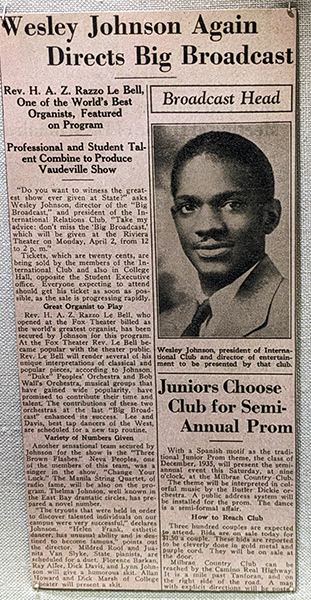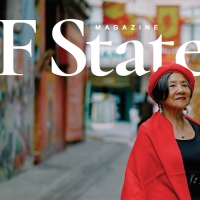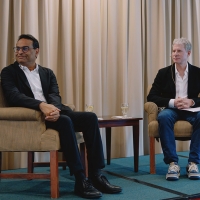SF State graduate founded America’s longest-running Juneteenth celebration

Wesley Johnson was a 1930s student activist before becoming a seminal entrepreneur in San Francisco’s Fillmore District
For the second time ever, the San Francisco State University campus will close on June 19 for Juneteenth. The festivities in San Francisco for the new federal holiday — which commemorates the emancipation of African American enslaved persons — have been rededicated to their founder, a San Francisco State alumnus named Wesley Johnson.
In 1945, Johnson created what would become the longest continuously running Juneteenth celebration in America. The native Texan announced it in grandiose fashion, riding a white stallion in the street and inviting passersby to celebrate at his Fillmore District nightclub. Nineteen years later, he established the Juneteenth parade in San Francisco, leading the way again on a white horse in his signature 10-gallon white Stetson cowboy hat to set off a three-day festival. This year the parade took place on June 8, alongside a month filled with festivals in several neighborhoods.
SF State alumna Melina Jones, who has served on the committee for the Juneteenth parade and festival, learned about Johnson when researching the history of the holiday for her annual “BlaCOEUR” Juneteenth event.
“I just got so excited about him and his legacy in the Fillmore during the Harlem of the West era of the ’40s and ’50s,” said Jones, a designer and rap artist born and raised in San Francisco. “I was incredibly proud just to be from here and to know that I get to be from a region where there are all of these innovators who are just brilliant cultural engineers.”
Wesley Johnson was born in 1908 in Galveston, Texas — the same city where Juneteenth celebrations began on June 19, 1866, one year after a Union Army general issued an order informing Texans that enslaved persons were now free. Although President Abraham Lincoln signed the Emancipation Proclamation on Jan. 1, 1863, it took two and a half years for the news to spread and for abolition to be enforced.
After World War I, when Johnson was still a teenager, he and his family moved to San Francisco. Due to racist housing covenants and redlining, African Americans were welcome to live in only three of the city’s neighborhoods; the Johnson family settled in the Fillmore District. He entered San Francisco State College when the campus was located on Haight Street with about 1,100 students, very few of them Black.
Several archival news clippings from the Golden Gater student newspaper, available in the University Archives in the J. Paul Leonard Library, highlight Johnson’s engagement in student life. In fall 1931, pledges from the Delta Sigma Theta sorority threw him a party to celebrate the birth of his second son. “Oh yes, all I need now is three more and I will have a basketball team!” Johnson quipped.
As president of the International Relations Club, Johnson directed “The Big Broadcast,” a live variety show on campus in the 1930s. Tickets were 20 cents each. “Do you want to witness the greatest show ever given at State?” Johnson said in the Golden Gater to promote the show.
SF State Associate Librarian Meredith Eliassen, the University’s archivist, notes that Johnson launched one of the first student organizations for African Americans. In 1935 he created the Utopian Club for African Americans to discuss social issues. The following year it became the Negro Students Club, which would eventually be replaced by the first-ever Black Student Union.
Eliassen says Johnson paved the way for students who decades later organized efforts to effect change, particularly the strike of 1968 – 1969 that resulted in the nation’s first College of Ethnic Studies.
“The issues for Black students in the ’30s were the same as the ’60s: They were paying a fee, but not getting an equal education,” Eliassen said, noting students were unhappy about exclusionary admissions policies and curricula that omitted persons of color.
After graduating from SF State, Johnson became one of the seminal entrepreneurs in the Fillmore District, as detailed in a Western Historical Quarterly article by Emily Blanck from 2019. The commercial corridor of Fillmore Street was thriving with African American-owned businesses, giving the area its status as the “Harlem of the West.” Among the area’s 20 nightclubs were Johnson’s Texas Playhouse (also known as Club Flamingo, with 15 hotel rooms above the ground floor) and the Congo. On any given night Johnson would be spinning jazz music and dancing “up and down the bar,” waitress Dorothy Alley said in the 2006 book “Harlem of the West: The San Francisco Fillmore Jazz Era” by Elizabeth Pepin (B.A., ’94) and Lewis Watts. Famous musicians like Billie Holliday and Louis Armstrong would visit and spend time with Johnson.
Johnson retired as grand marshal of the Juneteenth parade in the late 1980s. His legacy continues to grow, as people like Jones seek to share his story and his values with younger generations, with the aim to inspire as many as possible. She designed a new website and logo for Juneteenth in San Francisco. Unveiled just last month, the logo depicts a silhouette of Johnson on a white horse. Jones also wrote an article about Johnson for the Juneteenth San Francisco website.
“When he had these businesses, he looked incredibly impeccable. Everybody came with this allure and this air of excellence and pride — and he would not have it any other way,” Jones said. “You could see that he had this very unwavering desire to be excellent, and you could see it in all the pictures. I think he was extremely strategic and just very proud.”
Visit the University Archives in the J. Paul Leonard Library.

An archival news clipping from the Golden Gater, as seen on display in the J. Paul Leonard Library
Tags



